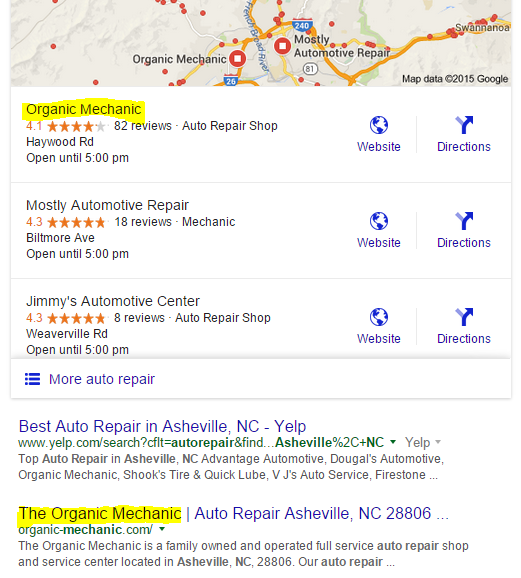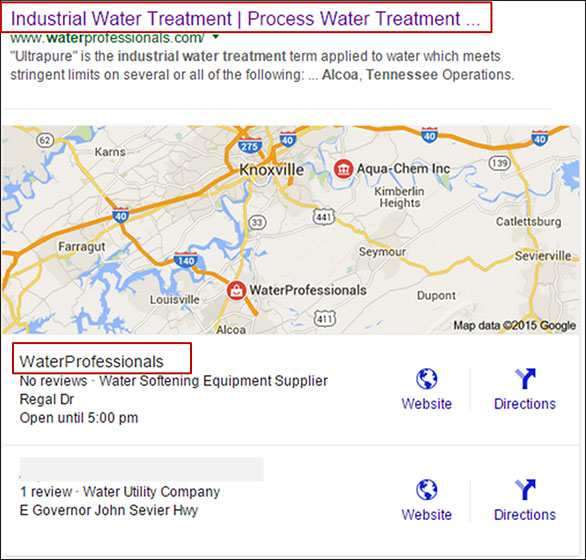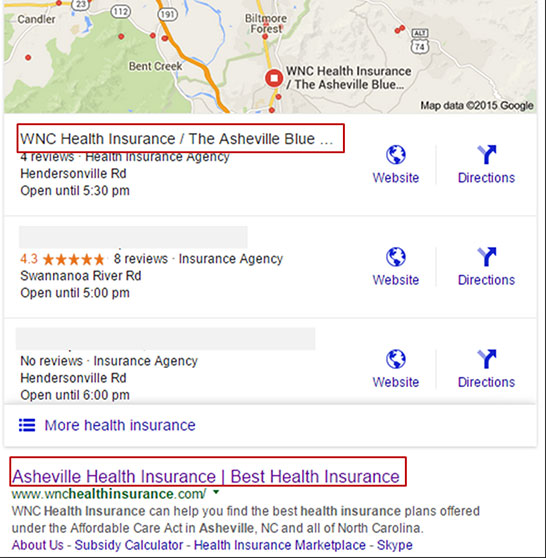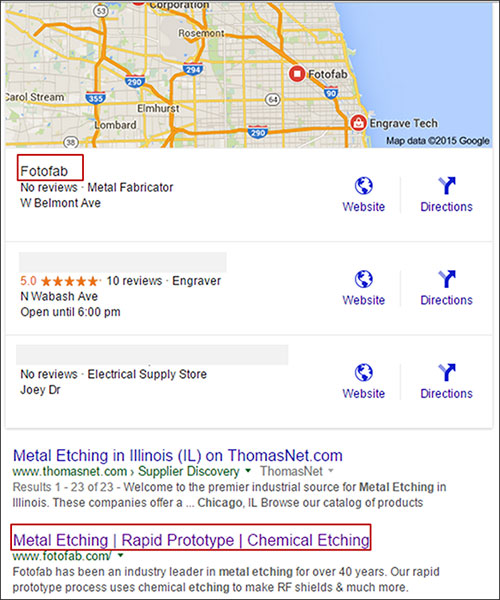How to Outrank Your Competitors in Google Local Search Results, continued
In Part 2 we presented advice on “How to Outrank Your Competitors in Google Local Search Results.” We introduced the main three factors that Google has revealed that it specifically takes into consideration when delivering local search results pages to users:
I. Physical Location
II. Relevance
III. Prominence
We focused on how much of an effect the physical location of your business has on where Google decides to list your website in the Google Local Search Results pack.
Now in this final post of the series, we share how relevance and prominence, the other two main factors, play major roles as Google decides which three business listings deserve a place in the three-pack that is Google Local Search Results.
II. Relevance
The second known ranking signal for Google Local Search Results is relevance. In other words, how closely do the products/services you provide match what the searcher is looking for when using google.com?
Google Local Search Categories
When creating your Google Business Profile, it’s important that you carefully select the most appropriate business category from Google’s provided list of categories first, as discussed in Part 1 of this series. Then select as many other additional categories that are related to the products/services that you provide, as you can. The category(ies) you select on your Google Business Profile will be one of the most influential signals in determining which queries (e.g. search phrases) your business appears for in Google Local Search Results. In addition, be sure to use the keywords for the category(ies) you select in the “About” section of your Google Business Profile. Be sure to use the keywords on your website as well.
Mobile Optimization
When it comes to performing Google searches, many users are routinely turning to their smart phones. Today’s smartphones are essentially mini computers that are always accessible, and Google recognizes this. That’s why Google recently began filtering local search results so that only businesses with mobile-friendly websites appear at the top of search results when searches are performed on smartphones.
If your website is not mobile-friendly and users are searching for your products or services on their phones, your website may be deemed not relevant to the searches, and your business may not appear in the local search results displayed to the users.
Businesses whose websites are not mobile-friendly, do still appear in Google Local Search Results when searches are performed on tablets and computers. However, we recommend (and can help with) making your website mobile-friendly to prevent losing potential exposure and sales from targeted mobile users.
Webpage Optimization
Another contributing factor to a website’s perceived relevance to online searches, is website content. This is where webpage optimization (a.k.a. Search Engine Optimization or “SEO”) and keyword optimization come into play. Websites that are strategically optimized for keywords related to the Google Local search categories, stand a greater chance of being recognized by Google as relevant, and thus will appear in Google Local Search Results. These optimized mobile-friendly webpages also have the added benefit of appearing at the top of organic search engine results (e.g. see figure 1).

From time-to-time the businesses listed in the top spots of the Google Local Search Results “pack” (a set of business listings near a map), also happen to occupy the top spot in the organic results beneath. This is because when website content is well optimized, it is clear to Google’s search engine algorithm that the webpage contains the information the user is searching for and is relevant.
Google’s Pack Update: the new “Snack Pack”
You may have noticed that Google Local Search Results packs began to look quite different in August than they did in July. This is because on August 6, 2015, Google made some major changes to the pack.
Google slimmed down its local search pack results from a 7-pack to a smaller 3-pack, or “snack pack.” If your business listing happened to be in the D, E, F or G positions, and it did not move up during the pack update, then it is no longer showing up in Google’s initial local search results display. Search engine users now have to click on the “More” link at the bottom of the pack listings, to see local pack listings beyond those in the coveted top 3 positions (A, B or C).
Google has also updated the overall layout of local search results. In the new 3-pack format, the local map is now above the top 3 business results instead of to the right of the results. The letters A through G are gone. A completely new “Directions” link is located just to the right of the business’s contact details. Lastly, rather than showing the website URL under a business’s name, a new “Website” link also shows up to the right of the business’s contact details. (e.g. see old results in Figure 1, Part 2 vs. new results in figure 1 in Part 3).
Business phone numbers are no longer displayed in the initial 3-pack view, but can be accessed by clicking on the listing for a business.
This redesign is a game-changer for local businesses, in the following ways:
- Business listings in the “snack pack” will gain traffic, because there is now less competition in the pack (only 3 business listings, instead of 7).
- Business listings that were in the 7-pack, but not in the top 3, stand to lose traffic, because there are no longer any D through G listings displaying for searchers. Those have been pushed over to the “more” pack page, and the letters don’t exist any more.
- Business listings that ranked too low to appear in the 7-pack, stand to gain traffic because the “more” pack page now includes 20 listings.
The coveted “snack pack” has now become even more competitive, and it’s tough for non-Google-experts to complete. If you want your business listing to achieve “snack pack” ranking, we are the pros who can help you get there.
Anchor Text
Another factor that the search engine algorithms use to determine what your business is about, is anchor text. Anchor text is the word or words that other websites use when linking to your website. Anchor text may include: keywords, or the name of your business, or words like “click here”, or your full website URL spelled out.
Anchor text can be practically anything and unfortunately you are not able to control the words that people use to link to your website. If keywords are used in anchor text, those keywords can be a signal to Google as to what a webpage is about. Keywords-as-anchor text works well but only if done in moderation.
Anchor text used to work very well as a signal to the search engines regarding what the webpage was about. But unfortunately, anchor text has been mis-used to try to trick the search engines, by some seedy characters. The search engines got wise to those tricks (like they always do), so now one must be very careful about the types of anchor text that is used to link to one’s website.
It is best to avoid having too many links to your website that are keyword-specific, or that consist of the same keywords. If you are concerned that you may not have a well-rounded mix of anchor text, an inbound marketing agency, like Net Site Marketing, can evaluate your anchor text and will work on your behalf to develop more (or a greater variety of) inbound links with strategically selected anchor text to your website in an ethical and natural manner – no tricks. This time-consuming process typically involves creating and promoting useful content that helps simultaneously build trust and authority. The process is commonly known as Content Marketing, and it is a cornerstone of Inbound Marketing.
III. Prominence.
The third ranking factor that Google claims it utilizes in determining a business’s rank in local search results is prominence. Prominence is essentially another word for popularity. How well known and how well liked is your business?
For well-known brands like Coke and Culligan, prominence comes easily. But how does Google determine the prominence of less nationally known businesses like local auto body shops? Two of the primary factors that we theorize Google looks at when determining the prominence of a local business, are the websites’ backlinks and number of visits.
Backlinks
A website’s inbound links are a strong signal to Google about its popularity and authority. This is why so many inbound marketers jump for joy when they achieve a coveted link from a government-run website, or the New York Times website, or the website of an educational institution like Harvard. These are all websites with very high authority and are well trusted. Having links from these types of websites sends a strong signal to Google that your website is trustworthy and/or is authoritative. Of course, these types of links are extremely challenging to obtain.
One of the best things a business can do to help improve its prominence is to be an active member in the community. For example, a business could sponsor a local non-profit organization. Sponsorships are not only great for building inbound links from trusted websites like your local Red Cross chapter, schools’ websites, and local charities, but they also offer the added benefit of brand recognition. By sponsoring non-profits, and community events, you are making your business a more prominent part of the community.
You should also consider investing in a membership with your local chamber of commerce and the Better Business Bureau. These are great places to get referral links and will help improve your prominence within your community.
Visits
Website traffic (a.k.a visits) is also believed to be a signal that Google utilizes in determining prominence. If your website:
- Receives a large number of clicks when it appears in search results for certain queries; and/or
- Receives a large number of visits from other relevant websites (referrals); and
- Visitors don’t just bounce right off of your website after they visit; then
- Google may perceive your website to contain relevant information and to be highly popular.
Of course, no one but Google knows the exact formula that Google’s local search algorithm utilizes in determining rankings. But there is hope!
Net Site Marketing has gained much success for its clients by doing the following for them:
- Improving social signals;
- Improving N.A.P. consistency;
- Building ethical and relevant inbound links; and
- Enhancing webpage optimization.
We have been able to successfully achieve top positions in Google Local Search Results for clients AND successfully achieve top organic positions at Google for clients AT THE SAME TIME! (e.g. see figures 2-4).



Is your website in the top three positions in Google Local Search Results? If it isn’t, but you would like it to be, contact us now for a free no-obligation quote, and let’s get you ranking well!
